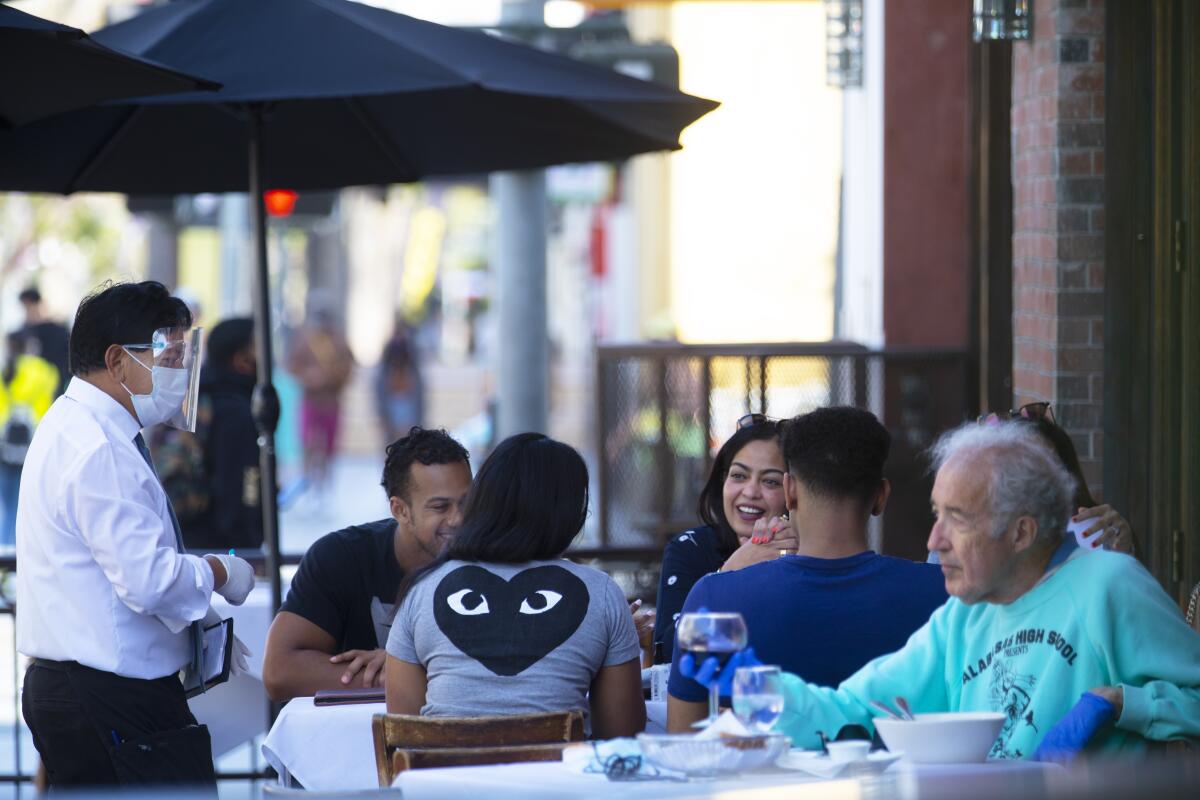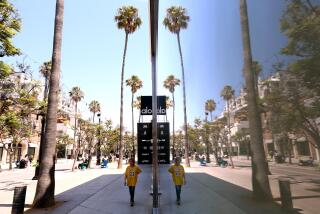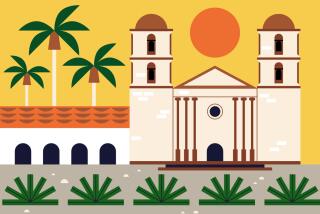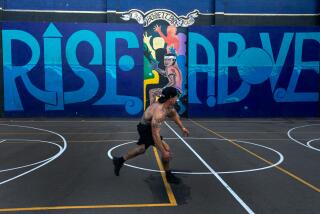One of Santa Barbara’s oldest streets is suddenly so popular it’s scary

- Share via
SANTA BARBARA — If you haven’t seen State Street in Santa Barbara lately, brace yourself. It’s gone car-less. The empty lanes are filled with young and old people eating, drinking or wandering on foot, on cycles, on scooters. Expect a big, happy crowd on a Saturday night.
And maybe mask up.
“It’s so wonderful, isn’t it?” said Ruth Marshall, who was walking her dog and wearing a face mask with a wide smile printed on it. “It’s like one big party.”
For decades, Santa Barbara’s main commercial artery has been pretty but problematic — a handsome street, full of tall trees, Spanish Revival architecture, stylish restaurants and boutiques, its sidewalk sometimes blocked by people in need of a home or mental health services or both.
For years, many Santa Barbarans have suggested that banning cars might help. It would create more room for foot traffic and outdoor dining, they said, and add a European feel.
“I have been asking since 2000, 2001,” said bar owner Dan Bahan. “But they rejected the idea, saying it would be Mardi Gras.”
The city did try a three-block, two-day test in 2019, but officials weren’t ready to make a bigger move.
Then in late May, after two months of pandemic and restrictions threatening to drive many restaurants, bars and shops out of business, the Santa Barbara City Council voted unanimously to make about a mile of State Street into a pedestrian promenade.
The experiment allows restaurants and bars to add seats and tables on the sidewalk, in the street and in parking lots, reclaiming some of the capacity lost when social distancing requirements were imposed. The new move also takes advantage of rules loosened by the state’s Department of Alcoholic Beverage Control.
The change began May 22. City workers added barricades and planters, liberating eight blocks from automobile rule, except for intersections. The number of restaurants with sidewalk seating has jumped from 15 to about 30. On Friday, bars without food service reopened, as did many major downtown hotels, whose guests can walk to the new promenade.
“They’ve been trying to liven up State Street, and this does it,” Marshall said.
Last weekend was the experiment’s busiest so far, surpassing Memorial Day weekend.
City officials say this is a work in progress and acknowledge they may need additional steps to safely accommodate both cyclists and pedestrians.
But the result is a street scene that will look familiar to anyone who has wandered on a Thursday night in downtown San Luis Obispo, when the farmers market takes over a prime stretch of Higuera Street. It may even remind some of the car-less portions of Calle Sierpes in Seville, Spain, or Las Ramblas in Barcelona.
In a full day of interviewing Santa Barbara locals and visitors on the blocks between Haley and Sola streets, I couldn’t find anyone who didn’t love it. Everyone wanted to make it permanent — a dramatic change for a thoroughfare that got its name in 1850.
For a city that has always prized its indoor-outdoor living, “this is a logical next step,” said Nina Johnson, senior assistant to city administrator Paul Casey. “But it took the urgency of the public health measure to make it happen.”
But will success spoil State Street?
People aren’t wearing masks. In a few minutes at State and Haley at 6 p.m. Sunday, I counted 69 adult pedestrians and cyclists without masks, 25 with them.
Get The Wild newsletter.
The essential weekly guide to enjoying the outdoors in Southern California. Insider tips on the best of our beaches, trails, parks, deserts, forests and mountains.
You may occasionally receive promotional content from the Los Angeles Times.
There was nothing illegal about that; Santa Barbara County’s health order required that you wear a face covering when entering a restaurant or other business but not while on the street. Rules are stricter in Los Angeles County, which requires face coverings whenever people are interacting with others who are not members of their household.
It’s likely more people will mask up now that Gov. Gavin Newsom has ordered that all Californians must wear a mask while in public or high-risk settings. That move tightens restrictions in many California counties, including Santa Barbara.
Health officials say they are still discouraging leisure travel, but state and local leaders throughout California have permitted the reopening of hundreds of hotels. This leaves Californians to sort out for themselves what they can do and what they should do.
The many bare-faced people on State Street “is a problem. It’s hard to figure that out,” said Johnson. “We are trying to monitor and make observations. We can send more messages to hotel guests or residents to encourage them to wear masks.” However, she noted, “we don’t have a technical method to measure mask-wearing.”
On the promenade, Reed Loose and Sarah Broad, both masked, both recent UC Santa Barbara grads who live downtown, said they had hoped to see more face coverings.
“It’s an easy thing that might help,” said Broad.
“Most people, a couple of weeks back, had masks on,” Reed said. The new influx of tourists could be the problem, but “I can’t tell,” he said.
On the 500 block of State Street, where the greatest number of bars and restaurants is concentrated, music leaked from the Red Piano and O’Malley’s bar.
Farther up the street, near the Lobero Theatre (on “intermission” since March), folk musicians had settled in to play some Irish music. All wore masks.
“We’re kind of old, some of us,” explained fiddler Eliot Jacobson, 62, drawing a laugh from Richard Ellsworth, also a fiddler, age 25.
As for the car-lessness, “we’ve been wishing for this for decades,” said Diane Soini, 55, holding a modified mandolin.
The city is still far from its old self. Many of State Street’s prime attractions, including several theaters and museums, are still closed. So are playgrounds, nightclubs and spas. So is the Mission Santa Barbara. The Santa Barbara Botanic Garden is open only to members with reservations.
Many hotels and destinations are eager to accelerate, but state health officials are still applying brakes
“It’s amazing how much you can cut through the red tape right now,” said Daryl Takehara, general manager of the popular sushi restaurant Arigato.
Nearby strolled Leila Avant (no mask) with her young son and husband (masked). They were from San Bernardino and had come to stroll and browse for a restaurant.
“I’ve been off and on” with the mask, Avant said. “I’m kind of living dangerously right now. He’s better than me.”
Her husband, who is in the military and declined to give his name, said he’s afraid the pandemic will worsen in fall. But in the meantime, he said, “this is a spectacular place.”
The promenade will stay car-less until at least Sept. 8, Johnson said. Then it’s up to the City Council.
As Johnson and others acknowledge, the promenade doesn’t fill retail vacancies, nor does it solve housing or mental health issues. But it does keep more money and people in motion.
And the city continues to get busier. The Santa Barbara Zoo is due to open June 23 (reservations required).
On Monday morning in State Street’s La Arcada Building, the barber shop had reopened.
At O’Malley’s, Dan Bahan was about to open for the day.
“Look,” he said, pointing out the young and old passers-by. “There are strollers on the street. … I know you’ve already got this in Santa Monica. But you’re going to start seeing these pop up in a lot of cities.”
If you go
•Sleeping: Dozens of Santa Barbara hotels opened June 12. I stayed one night at the nearly full Hotel Indigo on State Street and paid $190, including taxes. Other hotels within easy walk of the promenade: The recently redone Hotel Californian; the small, contemporary Haley Hotel, the Harbor View Inn and the Hotel Santa Barbara.
•Eating: Of four meals I had on or near State Street, my favorites were dinner at Arigato (zesty shiitake roll) and breakfast at D’Angelo Bread (light-as-air almond croissant).
•Details: Santa Barbara’s tourism organization has detailed information on what is and isn’t open in the city and environs.
• One more thing: Let your eyes meander on a downtown map and you’ll find Quarantina Street, which is no joke. It was named for two local outbreaks, apparently scurvy and smallpox, in the late 18th century.
More to Read
Sign up for The Wild
We’ll help you find the best places to hike, bike and run, as well as the perfect silent spots for meditation and yoga.
You may occasionally receive promotional content from the Los Angeles Times.








